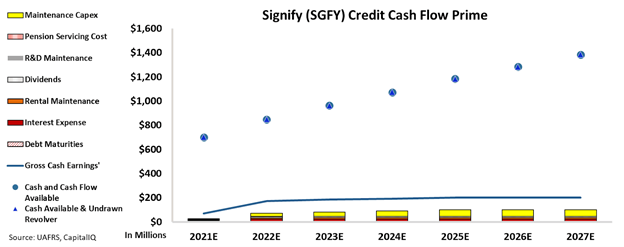The traditional “fee for service” healthcare model incentivizes maximizing the number of treatments, but “value-based care” focuses on the most cost-effective way to care for patients’ long-term health. Today’s FA Alpha Daily features Signify’s (SGFY) healthcare model and its overstated credit risk.
FA Alpha Daily:
Wednesday Credit
Powered by Valens Research
The United States is one of the most medically advanced countries in the world. And yet, inefficiency and inequality define how most Americans view the industry.
One of the most important revolutions in the United States to solve this inefficiency is a move away from the traditional way of approaching healthcare.
The traditional form of healthcare has been a “fee for service” model where caregivers and physicians are paid based on the number of treatments they provide. However, this encourages providers to prescribe the highest number of treatments, not solve the problem.
Trends in recent years have gravitated towards what is called “value-based care” where physicians are responsible for the “person” and not the individual treatment. Physicians and caregivers are incentivized to care about their patient’s long-term health in the most cost-effective way, by rewarding the best care provided.
The hope is that by implementing thoughtful care initiatives like prophylactic care and care at home, public health services like Medicare and others can see their costs reduced.
Companies that find themselves in the heart of this innovation, like Signify Health (SGFY), are well positioned to make significant returns if they can execute correctly on these efforts.
Equity markets have realized their immense upside, as Signify trades at a 35x Uniform P/E. However rating agencies seem to be missing the tailwinds in this industry.
When our team looked at Signify, we saw a surprisingly pessimistic rating from S&P.
S&P, which relies on GAAP accounting, is rating the firm as a B credit. This means they think there’s a 25% chance of it going bankrupt in the next five years.
However, we can figure out the true risk by examining it through the lens of Credit Cash Flow Prime.
In the chart below, the stacked bars represent the firm’s obligations each year for the next seven years. These obligations are then compared to the firm’s cash flow (blue line) as well as the cash on hand available at the beginning of each period (blue dots) and available cash and undrawn revolver (blue triangles).
Not only does Signify have strong cash flows that exceed operating obligations every year in the foreseeable future, but it also has strong cash buffers well in excess of their one debt maturity in 2028. Combined, we are left with a company that is facing very low risk of bankruptcy.
See for yourself:

S&P’s B credit rating isn’t reflective of Signify’s credit worthiness, but rather a sign of the rating agencies missing the company’s tailwinds.
That’s why we rate Signify as a much safer IG4 investment grade credit, and with the continued fundamental tailwinds, could be even stronger.
Signify is yet another company where the credit rating agencies don’t capture the complete story. While we at Valens recognize the flaws with traditional credit ratings, many creditors do not. The B credit rating is pessimistic and paints a picture of a company that is much riskier than it is in reality.
It is our goal to bring forward the real credit worthiness of companies, built on the back of better Uniform Accounting.
To see Credit Cash Flow Prime ratings for thousands of companies, click here to learn more about the various subscription options now available for the full Valens Database.
SUMMARY and Signify Health, Inc. Tearsheet
As the Uniform Accounting tearsheet for Signify Health, Inc. (SGFY:USA) highlights, the Uniform P/E trades at 56.5x, which is above the global corporate average of 24.0x, and its historical P/E of 22.6x.
High P/Es require high EPS growth to sustain them. That said, in the case of Signify Health, the company has recently shown a 50% Uniform EPS shrinkage.
Wall Street analysts provide stock and valuation recommendations that in general provide very poor guidance or insight. However, Wall Street analysts’ near-term earnings forecasts tend to have relevant information.
We take Wall Street forecasts for GAAP earnings and convert them to Uniform earnings forecasts. When we do this, Signify Health’s Wall Street analyst-driven forecast is for a 100% decline in 2021, but a 63% EPS growth in 2022.
Based on the current stock market valuations, we can use earnings growth valuation metrics to back into the required growth rate to justify Signify Health’s $14 stock price. These are often referred to as market embedded expectations.
The company is currently being valued as if Uniform earnings were to grow by 25% over the next three years. What Wall Street analysts expect for Signify Health’s earnings growth is below what the current stock market valuation requires in 2021, but above the requirement in 2022.
Furthermore, the company’s earning power in 2020 is 7x the long-run corporate average. Moreover, cash flows and cash on hand are more than 2x its total obligations—including debt maturities and capex maintenance. All in all, this signals a low credit risk.
Lastly, Signify Health’s Uniform earnings growth is below peer averages, but the company is trading above its average peer valuations.
Best regards,
Joel Litman & Rob Spivey
Chief Investment Strategist &
Director of Research
at Valens Research
This analysis of Signify Health, Inc. (SGFY:USA) credit outlook is the same type of analysis that powers our macro research detailed in the FA Alpha Pulse.


